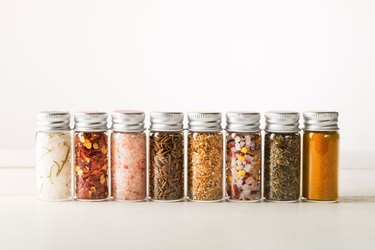
The reasons to rid your belly of that inch (or more) you can pinch aren't just about looks. Having overweight or obesity comes with serious health risks, including chronic diseases like diabetes, heart disease and some types of cancer, per the American Heart Association.
If you think you may have overweight or obesity, you can find out by determining your body fat percentage.
Video of the Day
Video of the Day
And if you want to drop down to a healthy weight, keep this in mind: Gimmicky shortcuts to reduce body fat percentage fast at best won't really work, and at worst aren't safe. Instead, follow these steps for real, long-lasting fat loss and better health.
1. Drink More Water
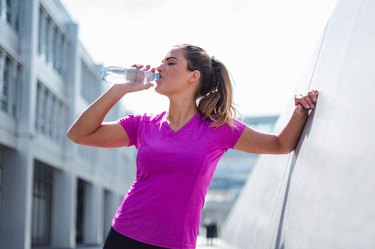
Skip high-calorie beverages with little to no nutritional value and grab a glass (or two) of water instead. This means forgoing flavored lattes, dessert-like coffees, juices, sweet tea, sugary cocktails and soda.
Water not only helps keep your body hydrated and functioning optimally, but it also continually flushes your system and can help boost your metabolism, per the American Council on Exercise (ACE).
Plus, drinking a full glass of water about 30 minutes before a meal can help prevent overeating, according to an August 2015 study in Obesity.
And remember to continue drinking water throughout the day. Many times, hunger and thirst signals can feel similar. So when you feel like snacking, drink a glass of water and see if the urge dissipates before noshing.
2. Increase High-Quality Protein
Adding more lean, protein-rich foods to your diet might just help you burn belly fat, according to a January 2012 study in Nutrition & Metabolism. What's more, a high-protein diet helps you hang on to lean muscle and keeps your metabolism chugging along at a good pace, per a May 2013 study in The Journal of Nutrition.
Examples of low-calorie, high-protein foods for weight loss include:
- Black beans
- Chicken breast
- Tuna
- Eggs
- Greek yogurt
- Tofu
- Shrimp
According to a December 2019 review and meta-analysis in Advances in Nutrition, you should increase your daily protein intake when cutting calories to lose weight. The study suggests aiming for 1.3 grams of protein per kilogram of body weight.
Keep in mind that a kilogram is about 2.2 pounds. So, if you weigh 200 pounds, for example, you should aim to eat about 118 grams of protein per day while losing weight.
3. Follow a Mediterranean Diet
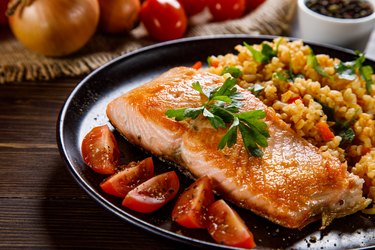
The Mediterranean diet is a much-lauded way of eating that prioritizes fruits, veggies, lean proteins and healthy fats such as avocado, nuts and olive oil.
A March 2019 Nutrients review linked the Med diet to weight loss as well as a lower body mass index and waist circumference (in other words, it may help you lose belly fat).
Another August 2019 study in the Journal of Hepatology, found that a lower-carbohydrate Mediterranean diet was more effective at reducing belly fat than a diet lower in fat.
4. Fill Up on Fiber-Rich Foods
Foods naturally high in fiber (like fruits and veggies) can help with weight management because they tend to be low in calories and packed with nutrients, according to Harvard Health Publishing.
In fact, one February 2015 Annals of Internal Medicine study found that people who simply aimed to eat 30 grams of fiber every day lost weight as effectively as those who followed a more complicated diet.
Another study, from the February 2012 issue of Obesity, found that when people increased their soluble fiber intake by 10 grams a day, they lost 3.7 percent of their belly fat over a five-year period (and that's without other changes to their diet or exercise).
Healthy fiber-rich foods to add to your diet include:
- Fruits like raspberries and blackberries
- Legumes like chickpeas and black beans
- Seeds, including chia and flaxseeds
- Lentils
5. Cut Down on Processed Foods
Processed foods may be convenient and tasty, but they're not doing our waistlines any favors.
Indeed, a December 2019 review in Current Treatment Options in Gastroenterology found a strong link between the growing popularity of ultra-processed foods (think: packaged desserts and snack foods with long lists of ingredients) and America's obesity epidemic.
Processed foods are associated with decreased satiety (that feeling of fullness after eating) and more weight gain, according to the authors.
In a smaller study, published May 2019 in Cell Metabolism, researchers set up a two-week trial with two groups of people, one that ate ultra-processed foods and one that ate unprocessed foods. Meals were matched for calories and macronutrients, but the people who ate the processed foods ate about 500 more calories per day and gained a pound of body fat.
6. Try Intermittent Fasting
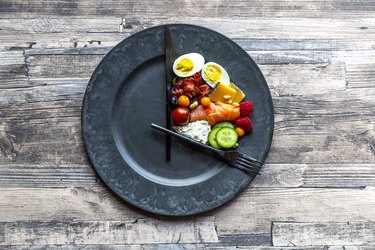
The research behind how many meals to eat each day and when to eat them is contradictory at times. Some studies suggest that grazing on small meals spaced two to three hours apart can help prevent you from pigging out come dinner time. Others point to intermittent fasting as being a good way to jumpstart fat loss and prevent overeating. (Though, keep in mind, there are many ways to do intermittent fasting.)
There's research to back this up: A December 2019 review in The New England Journal of Medicine found that, for adults who have overweight or obesity, intermittent fasting is just as effective as overall calorie restriction for reducing body fat.
Another study, in the February 2018 issue of the International Journal of Obesity, found that intermittent fasting could help people push past a weight-loss plateau and achieve greater fat loss. It's important to note, though, that this study only looked at men who had obesity.
There are many versions of intermittent fasting, but the 16:8 diet is among the most popular. It calls for eating during an eight-hour window and fasting for the other 16 hours (including the hours you're asleep). So, for example, you might start eating at 9 a.m. and stop at 5 p.m. each day.
Of course, it's still crucial to choose healthy foods during the "eating window." If nothing else, intermittent fasting eliminates late-night snacking, which is almost always a boon for fat loss and weight control.
7. Indulge Smarter

You've likely heard that antioxidants are good for your overall health, thanks to their ability to fight inflammation. But certain kinds of antioxidants — including the flavonoids found in dark chocolate — can help your body burn fat.
"These antioxidants can help boost metabolism, improve glucose control and even promote gut health, all of which contribute to weight control," says Melissa Schuster, RDN, CDN, dietitian and owner of Schuster Nutrition in New York City.
Indeed, a January 2016 meta-analysis in The BMJ found that eating even small amounts of flavonoids seems to help prevent weight gain and facilitate fat loss.
Yep, here's your permission to eat chocolate! The caveat: Keep it to 1 ounce of dark chocolate that is at least 70 percent cacao per day, advises Schuster. Or try adding raw cacao nibs to your oatmeal or yogurt.
"They are less processed than chocolate bars, naturally low in sugar, rich in minerals and antioxidants and a good source of fiber," she says.
8. Sip Green Tea With Lemon
Speaking of antioxidants, those found in green tea and lemon may help reduce your body fat, too.
A December 2013 Journal of Research in Medical Sciences study notes that the combo of antioxidants and caffeine in green tea can promote fat loss and calorie burn. Researchers found that drinking four cups of green tea per day was linked to decreased weight and wait circumference.
More recently, a May 2020 meta-analysis in Phytotherapy Research found that drinking green tea for longer than 12 weeks was associated with a lower body mass index and body weight.
Add lemon to your green tea for even more fat-burning power: The antioxidant-rich citrus fruit helps improve the body's ability to metabolize fats, according to March 2019 research in Oxidative Medicine and Cellular Longevity.
9. Spice Up Your Life
If you're battling belly fat, it may pay to spice things up just a bit. A December 2017 study in Metabolism found that cinnamaldehyde, an essential oil that gives cinnamon its distinctive taste, induces fat cells to start burning calories through thermogenesis (body heat production). While the researchers cautioned that further study is needed to determine how much is too much to avoid adverse effects, it can't hurt to sprinkle a little in your morning cup of joe.
And while you're at it, you might try adding a little spice to everything you cook.
"There is some evidence to suggest that certain spices, such as red and black pepper and ginger, can help with weight loss and weight maintenance," Schuster says. "These spices also have anti-inflammatory effects, which is beneficial for overall health, and especially for diseases like high blood pressure, cardiovascular disease and diabetes."
Red pepper, specifically, has a compound called capsaicin that acts as a thermogenic chemical, according to the Cleveland Clinic, meaning that it stimulates your metabolism and helps burn fat.
Still, while adding spices to food might help in a small way with weight loss and anti-inflammation, they are only one piece of a much larger picture, cautions Schuster: "It's also important to focus on lifestyle and behavior changes with weight loss, such as portion control, increasing fruits and vegetables and incorporating exercise."
10. HIIT It!
Getting your diet in check is just one part of the fat-loss equation, but exercise is important, too.
To maximize fat burn, spend two or three days a week doing high-intensity interval training (HIIT).
In an April 2012 study in the Journal of Obesity, researchers found that this type of workout can help reduce body fat, improve aerobic fitness and help preserve lean body mass (aka muscle).
To mix things up, apply this method to any form of cardio you enjoy the most — running, cycling, stair-climbing, jumping rope, elliptical training or rowing. Start your workouts with a light, five-minute warm-up, and then alternate back and forth from high to low intensity. For example, you can sprint for 30 seconds, and then jog or walk for one to two minutes, repeating for 15 to 20 minutes. Finish with an easy five-minute cool-down.
11. Build Muscle to Burn More Fat

Cardio isn't the only way to help your body burn fat. Adding muscle to your body means you'll burn more calories at rest, per the Mayo Clinic.
In one October 2013 study in the International Journal of Cardiology, strength training reduced belly fat in 78 people with metabolic syndrome.
And another August 2012 study in BMC Public Health, found that pairing strength training and cardio for 12 weeks was more effective at reducing body fat and belly fat than cardio alone.
In your strength-training sessions (aim for two or three a week), do multi-joint exercises, such as bench presses, upright rows, bent-over rows, squats and deadlifts. These compound exercises work more than one muscle at a time and promote fast muscle gain, according to the ACE.
Plus, they more closely mimic everyday activities (as opposed to isolation exercises, like biceps curls), helping prevent injury and building stamina. Start with three to five sets of 10 to 12 reps of each exercise.
12. Increase Your Time Between the Sheets
Lack of adequate sleep — even for just a few days — can affect how your body stores fat from food, according to a November 2019 Journal of Lipid Research study. Researchers found that sleep-deprived people tend to store fat more quickly and feel less satiated after eating.
Not getting enough sleep can also sabotage your weight loss. When you restrict calories in a sleep-deprived state, you lose more lean mass (aka muscle) than fat, according to October 2010 research in the Annals of Internal Medicine.
You should aim to log seven to nine hours of sleep each night, per the Centers for Disease Control and Prevention.
13. Add Probiotics to Your Diet
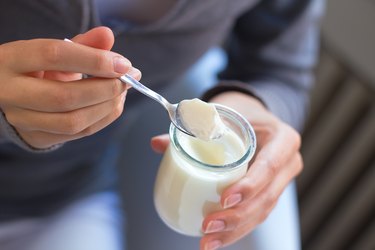
Probiotics are friendly bacteria that may benefit your gut health. They're found in fermented foods like yogurt, sauerkraut and tempeh, and also in supplement form. Either may help with reducing body fat.
One February 2018 systematic review and meta-analysis in Obesity Reviews found that people who took probiotics saw significantly larger reductions in fat percentage, body weight and body mass index than people who took a placebo.
Another study — this one much smaller, including only 28 people — found that eating yogurt with specific probiotic strains (Lactobacillus fermentum or Lactobacillus amylovorus) was linked to a 3 to 4 percent reduction in body fat. It was published January 2013 in the Journal of Functional Foods.
Restaurants are known as the nemesis of the healthy eater. But it is definitely possible to enjoy meals out while sticking to your resolve to reduce body fat.
You might be giving up some control by not cooking the meal yourself, but you can still make smart choices. Scan the menu carefully before ordering, and ask your waiter if you're unsure how something is prepared.
Stick with foods that are boiled, broiled, baked or steamed rather than fried, per the Mayo Clinic. And choose entrees that come with veggies or a salad instead of fries. Avoid excess dressing (ask for it on the side), cheese-centric dishes and cream sauces, as these can all pack a lot of extra calories.
- World Health Organization: "Obesity and Overweight"
- Metabolism: "Cinnamon turns up the heat on fat cells"
- American Heart Association: "Body Mass Index (BMI) In Adults"
- American Council on Exercise: "8 Things that Slow Down Your Metabolism"
- Obesity: "Efficacy of water preloading before main meals as a strategy for weight loss in primary care patients with obesity: RCT"
- Mayo Clinic: "Make healthy choices at any restaurant"
- Journal of Obesity: "The Effect of High-Intensity Intermittent Exercise on Body Composition of Overweight Young Males"
- Mayo Clinic: "Metabolism and weight loss: How you burn calories"
- American Council on Exercise: "5 Benefits of Compound Exercises"
- The Journal of Nutrition: "Normal protein intake is required for body weight loss and weight maintenance, and elevated protein intake for additional preservation of resting energy expenditure and fat free mass"
- Nutrition & Metabolism: "Quality protein intake is inversely related with abdominal fat"
- Advances in Nutrition: "Protein Intake Greater than the RDA Differentially Influences Whole-Body Lean Mass Responses to Purposeful Catabolic and Anabolic Stressors: A Systematic Review and Meta-analysis"
- Nutrients: "Mediterranean Diet and Cardiodiabesity: A Systematic Review through Evidence-Based Answers to Key Clinical Questions"
- Journal of Hepatology: "The beneficial effects of Mediterranean diet over low-fat diet may be mediated by decreasing hepatic fat content"
- Harvard Health Publishing: "Making one change — getting more fiber — can help with weight loss"
- Annals of Internal Medicine: "Single-Component Versus Multicomponent Dietary Goals for the Metabolic Syndrome"
- Current Treatment Options in Gastroenterology: "Beyond the Calories—Is the Problem in the Processing?"
- Cell Metabolism: "Ultra-Processed Diets Cause Excess Calorie Intake and Weight Gain: An Inpatient Randomized Controlled Trial of Ad Libitum Food Intake"
- International Journal of Obesity: "Intermittent energy restriction improves weight loss efficiency in obese men: the MATADOR study"
- The BMJ: "Dietary flavonoid intake and weight maintenance: three prospective cohorts of 124 086 US men and women followed for up to 24 years"
- Journal of Research in Medical Sciences: "The effects of green tea consumption on metabolic and anthropometric indices in patients with Type 2 diabetes"
- Phytotherapy Research: "The effect of green tea supplementation on obesity: A systematic review and dose–response meta‐analysis of randomized controlled trials"
- Oxidative Medicine and Cellular Longevity: "Modulating Oxidative Stress in Drug-Induced Injury and Metabolic Disorders: The Role of Natural and Synthetic Antioxidants"
- Cleveland Clinic: "Can Cayenne Pepper Speed Up Your Metabolism?"
- International Journal of Cardiology: "Different modalities of exercise to reduce visceral fat mass and cardiovascular risk in metabolic syndrome: the RESOLVE randomized trial"
- BMC Public Health: "The effect of 12 weeks of aerobic, resistance or combination exercise training on cardiovascular risk factors in the overweight and obese in a randomized trial"
- Journal of Lipid Research: "Four nights of sleep restriction suppress the postprandial lipemic response and decrease satiety"
- Annals of Internal Medicine: "Insufficient Sleep Undermines Dietary Efforts to Reduce Adiposity"
- Centers for Disease Control and Prevention: "How Much Sleep Do I Need?"
- Obesity Reviews: "Effects of probiotics on body weight, body mass index, fat mass and fat percentage in subjects with overweight or obesity: a systematic review and meta-analysis of randomized controlled trials"
- Journal of Functional Foods: "Lactobacillus fermentum and Lactobacillus amylovorus as probiotics alter body adiposity and gut microflora in healthy persons"
